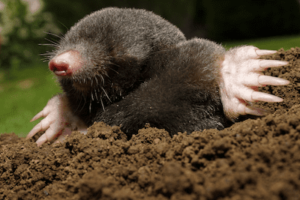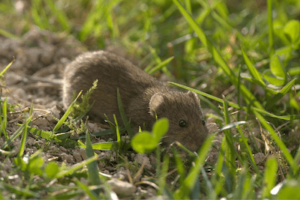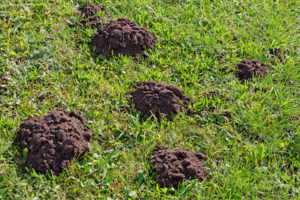What is the Difference Between Moles and Voles?
When it comes to common yard pests, there are many. It is important to know how to identify these pests so that you can quickly and effectively stop them from destroying your beautiful lawn! Two of the most common yard pests are moles and voles. With such similar names, these animals are often confused with one another.
So, what are the differences between moles and voles? This is a common question that people ask themselves when trying to decipher between the two animals. In addition to the differences in their physical appearance, moles and voles have a few other differences. While moles eat meat (most of the time insects), voles are herbivores. However, despite their differences, both moles and voles can wreak havoc on your garden or lawn.
Many wonder if moles can be harmful to them and their family, or what types of other animals they might attract to their lawns. In this article, we will be discussing the difference between the two and if they share any similarities. This will help you understand which species you currently might have on your lawn, and give you the proper information as to how to get rid of them safely.
What Is a Mole?
 Moles are often known for being a cute furry animal that appears in movies and cartoons. The moles we are talking about here, however, are not the adorable creatures from your favorite childhood movies. Moles are closely related to shrews.
Moles are often known for being a cute furry animal that appears in movies and cartoons. The moles we are talking about here, however, are not the adorable creatures from your favorite childhood movies. Moles are closely related to shrews.
Moles are insectivores, which means they eat insects as their main source of food. They have an incredible sense of smell and hearing abilities so they can easily sniff out their prey which can also include mollusks, insects, earthworms, reptiles, amphibians, birds, and sometimes even small mammals.
Moles have incredibly powerful front legs to dig through just about anything including concrete floors with ease. They have small eyes and ears, but they rely mostly on their nose to find food. Moles have been known to create tunnels under sidewalks and streets due to their poor eyesight from digging up soil looking for food.
Moles are very helpful because they get rid of harmful insects such as crickets and ants. They are considered to be very beneficial animals that can help humans control insect populations.
What Is a Vole?
 A vole is a rodent species related to the mouse family. There are over 150 species of voles that can be found all across the world. Voles are larger than mice and tend to have a stouter, bigger body with shorter tails. Most voles tend to vary in color from browns or grey depending on their habitat, but they will always have a lighter belly.
A vole is a rodent species related to the mouse family. There are over 150 species of voles that can be found all across the world. Voles are larger than mice and tend to have a stouter, bigger body with shorter tails. Most voles tend to vary in color from browns or grey depending on their habitat, but they will always have a lighter belly.
They grow anywhere from three to seven inches long with an additional five inched for their tail size, which is nearly hairless except for the tip of the tail. They are also herbivores, so their diet consists of plants.
There are two types of voles commonly known as meadow voles and woodland voles, both of which are considered pests by humans if they live in an area where their homes are close enough to human habitats. Both voles can damage food crops due to their herbivorous diet.
Voles can also be carriers of diseases such as Lyme disease, Tularemia, and Rat-bite fever. If voles can get into your home or business, they can cause damage by chewing through wood, wires, insulation in the walls, flooring, furniture, and much more.
How Are Voles Different From Moles?
Now that you have a better understanding of voles compared to moles, let’s talk about how voles are different based on their physical characteristics. Moles have larger front feet with claws for digging up the soil to search for insects, while voles have small paws that would not likely cause any harm if touched by them.
When it comes to ears, vole ears are nearly undetectable because they are so small. On the other hand, moles have larger ears that stick out of their head. Voles typically possess a lighter-colored belly, while moles are darker.
Voles live in burrows near the surface of the ground. They are rarely seen because they are nocturnal. There are more voles than moles, but they usually stay away from human habitation while moles are often considered pests. Voles create burrows underground that appear similar to those created by their counterparts.
Voles also have a larger body size compared to moles, and voles have thinner fur with grayer underbellies, unlike the thicket brown color of mole fur. Moles’ feet are also different from voles – a vole’s hind feet are smaller than its front feet, whereas a mole has large shovel-like front paws that aid them in digging tunnels.
What Attracts Moles to Your Lawn?
There are many things that moles find attractive on a lawn. For starters, moles love moist soil. They prefer to build their tunnels under mounds of dirt and grass where it is soft and moist.
Moisture is also needed because moles need water for survival; they can go weeks without food but only days without water. Therefore moles will do whatever possible to make the ground more humid like producing molehills or digging new tunnels closer to underground sources of water such as your faucet or pool.
Moles also like fertile soil that has higher levels of nitrogen which makes the plant grow larger with more nutrients for moles to eat when searching for insects underneath the soil surface. They prefer an area free of obstacles such as mowing or fences.
If moles can’t dig their way through an obstacle, they will not use your garden as the main tunnel but instead, make a side passageway to get from point A to point B. These are the most attractive choices moles look for on a lawn before deciding whether or not it is suitable for them to live there.
Soil Aeration to Prevent Mole Tunnels
Soil aeration and thatch control are also important when fighting moles in your yard. Moles typically come out of their tunnels at night and do most of their digging underground during this time. They only return to the surface every once in a while during the day when it is moist outside. This makes soil aeration ideal because moles usually avoid waterlogged soil; if moles travel through a waterlogged area, moles may drown trying to escape.
Molehills that form on the surface of your lawn are also a sign moles have been living there because moles pile up dirt from their tunnels to either provide better traction or leave scent markings to warn other moles of predators.
Molehills can be 1-2 inches across and around 3 inches tall; mounds created by moles are conical in shape with no vegetation growing atop them. You may need to gently push down on the molehill for it to flatten back into the ground; if the hill remains rigid, then you’ve found out why your lawn is losing its height!
Do Voles Create Tunnels Like Moles?
There are many different species of voles, but they all create similar mazes of tunnels underground. Vole mazes can be easily confused with mole mazes because both mammals dig long and intricate tunnel systems in search of food and shelter. However, these two tunnel-digging animals have drastically different environments and behaviors that influence the way they shape their mazes.
Mole Tunnels and Vole Tunnels
 So, what are the differences between mole tunnels and vole tunnels? Mole mazes tend to look like much more complex versions of vole mazes. If you laid out a map of the tunnels created by both mammals, it would be difficult to distinguish one from the other unless you were told where each type of maze started and where it ended.
So, what are the differences between mole tunnels and vole tunnels? Mole mazes tend to look like much more complex versions of vole mazes. If you laid out a map of the tunnels created by both mammals, it would be difficult to distinguish one from the other unless you were told where each type of maze started and where it ended.
Moles are digging mazes underground to search for insects, moles, and other small creatures to eat. They dig tunnels so they can follow the movements of the prey easily without being seen.
If their prey can escape by running away quickly, moles will have a difficult time following them through mounds of earth that form when moles exit their tunnels. Moles need mazes with many different access points because moles are blind and do not have good hearing or smell either.
Moles leave behind mounds of dirt forming molehills on grassy surfaces as a result of the digging and exiting out of nearby mole tunnels in search of food underground.
Voles will dig mazes that look similar to moles because voles eat insects and other creatures that live underground. However, voles do not hunt nearly as much as moles do so their mazes are generally less complex than those made by moles. Even though voles create simpler mazes than moles do, voles still need several different access points for their tunnels so they can escape predators quickly if necessary.
In Conclusion
From experience, I have had moles and voles in my garden, and both are equally destructive to all plants and grass. These creatures are different in many ways. One cannot determine the difference between the two when looking at a destroyed lawn. The best and most effective way to get rid of one of these animals is to plant daffodils, marigolds, or alliums in your yard. This safely gets rid of them without harm due to their severe dislike of these plants.
Hopefully, this helps you understand the difference between voles and moles. This is certainly an important topic because if not handled correctly, they can become harmful to humans or their property. If you are having problems with voles or moles in your lawn, contact a professional exterminator for assistance with safely removing them so they don’t cause any more damage.

